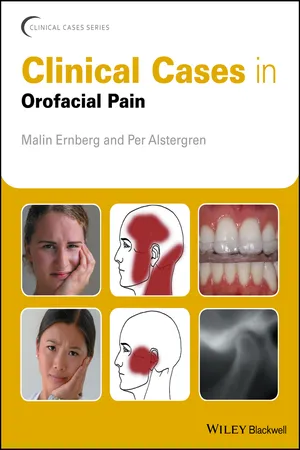
- English
- ePUB (mobile friendly)
- Available on iOS & Android
Clinical Cases in Orofacial Pain
About this book
Expand your knowledge and put it into practice with this unique, case-based guide
Clinical Cases in Orofacial Pain is a valuable resource for undergraduate dental students as well as residents working towards board certification. Individual cases cover temporomandibular joint disorders, masticatory muscle disorders, headache, neuropathic pain, dental pain, tooth wear, and dystonia. Following the popular Clinical Cases series style, cases are presented with associated academic commentary, including background information, diagnostic criteria and fundamental points that might influence the diagnosis, treatment planning or management of the case.
Well-illustrated throughout, each chapter features self-assessment study questions to help foster independent learning. Clinical Cases in Orofacial Pain is an excellent primer for undergraduate dental students and an invaluable study guide for postgraduate students and residents. Dental practitioners will also want to keep this unique, case-based guide as a ready reference in their working libraries.
Frequently asked questions
- Essential is ideal for learners and professionals who enjoy exploring a wide range of subjects. Access the Essential Library with 800,000+ trusted titles and best-sellers across business, personal growth, and the humanities. Includes unlimited reading time and Standard Read Aloud voice.
- Complete: Perfect for advanced learners and researchers needing full, unrestricted access. Unlock 1.4M+ books across hundreds of subjects, including academic and specialized titles. The Complete Plan also includes advanced features like Premium Read Aloud and Research Assistant.
Please note we cannot support devices running on iOS 13 and Android 7 or earlier. Learn more about using the app.
Information
Chapter 1
Diagnostics of Orofacial Pain and Temporomandibular Disorders
Diagnostic Classifications
The most common temporomandibular disorders
Less common temporomandibular disorders: the expanded taxonomy
Table of contents
- Cover
- Title Page
- Copyright
- Dedication
- Table of Contents
- List of Contributors
- Preface
- Acknowledgments
- Abbreviations
- Chapter 1: Diagnostics of Orofacial Pain and Temporomandibular Disorders
- Chapter 2: Temporomandibular Joint Disorders
- Chapter 3: Masticatory Muscle Disorders
- Chapter 4: Other Orofacial Pains
- Index
- End User License Agreement